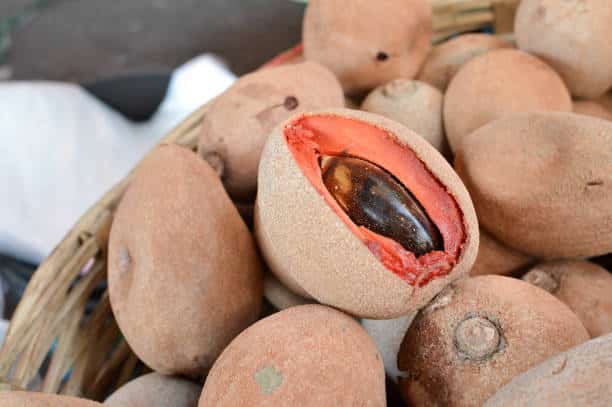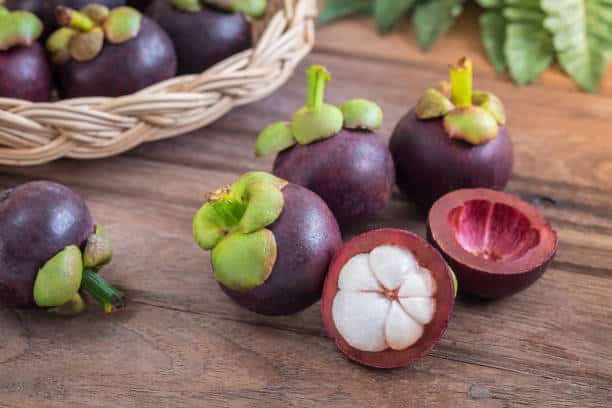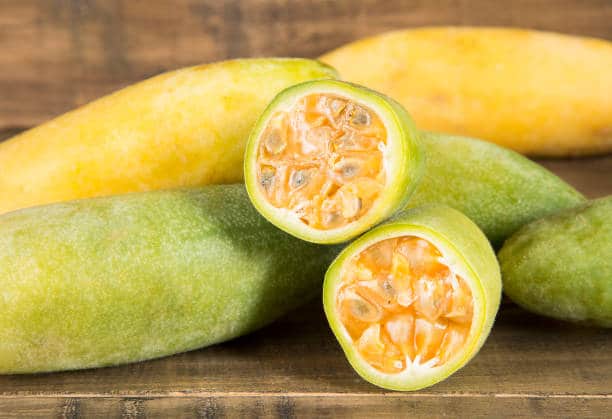Contents
- Common Fruits in Spanish
- Tropical Fruits in Spanish
- Berries in Spanish
- Nuts in Spanish
- Exotic Fruits in Spanish
- Fun Facts About Exotic Fruits in Spanish
- Lulo / Naranjilla — Little Orange
- Níspero — Japanese Plum
- Martillo — Lotus Fruit
- Uchuva — Inca Berry
- Zapote — Mamey Sapote
- Chontaduro — Peach Palm
- Mangostino — Mangosteen
- Mamoncillo — Spanish Lime
- Carambola — Starfruit
- Borojó — Head Fruit
- Curuba — Banana Passionfruit
- Tuna — Prickly Pear Fruit
- Pepino Dulce — Sweet Cucumber
- Fruit-related Vocabulary
- And One More Thing…
70+ Fruits in Spanish (With Audio)

Learning how to talk about fruit ( fruta ) is essential for any Spanish learner. But what about the more exotic kinds? If you travel to a Spanish-speaking country (particularly in Latin America) you’ll probably be blown away by the amount of exotic fruit.
The wide variety and interesting names for these fruits can be intimidating—not to mention that the names may change based on what region you’re in. Below we’ll teach you the most common Spanish fruit names as well as some delectable exotic fruits you need to try.
Download: This blog post is available as a convenient and portable PDF that you can take anywhere. Click here to get a copy. (Download)
Common Fruits in Spanish
Here are some Spanish names for fruit that you’re likely familiar with:
- Banana / Plátano — Banana
- Manzana — Apple
- Fresa / Frutilla — Strawberry
- Pera — Pear
- Sandía — Watermelon
- Naranja — Orange
- Uva — Grape
- Aguacate / Palta — Avocado
- Cereza — Cherry
- Melocotón / Durazno — Peach
- Melón — Melon
- Cantalupo — Cantaloupe
- Toronja / Pomelo — Grapefruit
- Lima — Lime
- Limón — Lemon
- Ciruela — Plum
- Tomate — Tomato
- Albaricoque / Damasco — Apricot
- Dátil — Date
- Limón sutil — Key lime
- Ciruela — Plum
- Pasa — Raisin
- Oliva / Aceituna — Olive
- Mandarina — Tangerine
Tropical Fruits in Spanish
- Mango — Mango
- Piña / Ananás — Pineapple
- Papaya — Papaya
- Kiwi — Kiwi
- Coco — Coconut
- Higo — Fig
- Maracuyá — Passion fruit
- Pitahaya / Pitaya — Dragonfruit
- Yaca — Jackfruit
- Nectarina — Nectarine
Berries in Spanish
- Mora — Berry
- Zarzamora — Blackberry, Boysenberry
- Arándano / Mora azul — Blueberry
- Arándano / Arándano rojo — Cranberry
- Frambuesa — Raspberry
- Granada — Pomegranate
- Grosella / Uva espina — Gooseberry
- Baya de saúco — Elderberry
- Guayaba — Guava
- Mora de Castilla — Andean raspberry
- Asaí — Açai
Nuts in Spanish
- Almendra — Almond
- Cacahuate / Cacahuete — Peanut
- Castaña — Chestnut
- Avellana — Hazelnut
- Pistacho / Pistache — Pistacho
- Macadamia — Macadamia
- Nuez — Walnut
- Pacano / Pecán — Pecan
- Anacardo / Nuez de la India — Cashew
- Piñón — Pine nut
Exotic Fruits in Spanish
- Kiwano — Horned melon
- Pomarrosa — Rose apple
- Jobo / Ciruela amarilla — Hog plum
- Chirimoya — Cherimoya
- Jícama — Jicama
- Papayuela — Mountain papaya
- Lulo / Naranjilla — Little Orange
- Níspero — Japanese Plum
- Martillo — Lotus Fruit
- Uchuva — Inca Berry
- Zapote — Mamey Sapote
- Chontaduro — Peach Palm
- Mangostino — Mangosteen
- Mamoncillo — Spanish Lime
- Carambola — Starfruit
- Borojó — Head Fruit
- Curuba — Banana Passionfruit
- Tuna — Prickly Pear Fruit
- Pepino Dulce — Sweet Cucumber
Fun Facts About Exotic Fruits in Spanish
Lulo / Naranjilla — Little Orange
The word lulo is only heard in Colombia or around Colombians.
Naranjilla is the word for the same Spanish fruit that is used throughout the rest of Latin America, especially Ecuador. Lulo and naranjilla are such favorites that they’ve even made lollipop flavors out of them in both countries—a must-try!
Níspero — Japanese Plum
These are found in all tropical regions, Latin America and Asia.
In southern areas of Mexico, they’re uniquely called mísperos and are heavily associated with the Day of the Dead because they’re placed on altars as offerings.
Martillo — Lotus Fruit
Native to Asia, martillo has made its way into Latino culture. It’s held in high regard in Indian and Asian culture (the lotus flower is both India and Vietnam’s national flower).
Uchuva — Inca Berry
This one is native to Peru and has interesting names in both Spanish and English.
In Latin America, physalis is also called uchuva (in Colombia particularly) and uvilla (in Ecuador), and the latter literally translates to “little grape.”
Zapote — Mamey Sapote
This fruit is native to Mexico, Central America and northern parts of South America, and it has tons of variations.
Most Latino countries call them sapote or sapodilla, which describes a smaller version.
In Colombia they call them zapote, mamey or zapote mamey. Both zapote and mamey are heard with equal frequency in Colombia.
On the other hand, mamey is the most common name used in Mexico.
Chontaduro — Peach Palm
I must admit that this one doesn’t taste fruity, but it’s still considered a fruit! It has more of a sweet potato, hominy, chestnut flavor and comes from a type of palm tree.
There are loads of Spanish names for this fruit:
Bolivia — tembe
Colombia — chontaduro or cachipay
Costa Rica and the Dominican Republic — pejibaye or pejiballe (different spellings, same sound)
Panama — pifá or pixbae
Guatemala — manaco
Nicaragua — pijibay
Venezuela — pijiguao or macana
Ecuador — chonta or chontaduro
Peru — pijuayo
Mangostino — Mangosteen
This is another fruit native to the Asian tropics that’s also typical in Latin America. Some countries—like Colombia—use the word mangostán to also refer to the fruit.
Mamoncillo — Spanish Lime
This one literally translates to “little sucker,” and it’s found throughout all of Latin America.
Other names for mamoncillo are quenepa and guaya, both heard in Puerto Rico and Mexico. Others are mamón (for short) and limoncello.
Limoncillo is mostly heard in Central America and the Dominican Republic.
Quenepa is so famous in Puerto Rico that there’s even a festival that celebrates it (Festival Nacional de la Quenepa), particularly in the city of Ponce, where the fruit grows abundantly.
Carambola — Starfruit
Another Spanish fruit that finds its roots in Asia, carambola is now heavily cultivated in Latin America, Africa and the rest of the world.
Here are variations of the name:
Dominican Republic — cinco dedos (five fingers)
Venezuela — tamarindo chino (Chinese tamarind) tamarindo dulce (sweet tamarind)
Costa Rica — tiriguro
Spain — fruta estrella (a literal translation from the English star fruit name)
Borojó — Head Fruit
Native to Panama, Colombia, Costa Rica and some parts of Ecuador, borojó is considered a sort of Viagra fruit because of its aphrodisiac and energetic properties.
Some vendors even call it el jugo del amor (love juice) since it’s a famous smoothie and mousse option.
Curuba — Banana Passionfruit
Curuba is the largest of the passion family (longer and more oblong in shape) and for that it’s officially called “banana passion fruit” in English.
Similar to gulupa and maracuyá, the slang names for curuba are semi-alike, but still quite out of the ordinary:
Ecuador — taxo
Venezuela — parcha
Peru — trompos or tintín
Bolivia — tumbo, curuba
Tuna — Prickly Pear Fruit
Tuna is highly celebrated in Mexico and can be served in a chilled or warm salad, in dry deserts or sometimes fried and sauteed as a side, because it accompanies savory dishes well.
Other Latino names include: sabra, chumbera and higo (higo usually means fig in Spanish, but they call it this because it’s considered a cactus fig). In Argentina nopal is known as penepes.
Pepino Dulce — Sweet Cucumber
As indicated by the name, the taste of this fruit resembles a mixture of melon and cucumber!
This fruit belongs to the Americas, native to the Andes regions. There are no other funky names for this one, but some like to call it pepino.
Fruit-related Vocabulary
It’s good to know some other words that will help you talk about fruit:
- Dulce — Sweet
- Agrio — Sour
- Amargo — Bitter
- Maduro — Ripe
- Semillas — Seeds
- Cáscara — Peel
- Hueso / — Pit
- Pelar — To peel
- Comer — To eat
The best way to learn the words about or related to fruit in Spanish is to try them out yourself, or hear them in use.
Even if you can’t talk to a Spanish native, you can check out FluentU, a language learning program geared to teach you Spanish through subtitled videos.
FluentU takes authentic videos—like music videos, movie trailers, news and inspiring talks—and turns them into personalized language learning lessons.
You can try FluentU for free for 2 weeks. Check out the website or download the iOS app or Android app.
P.S. Click here to take advantage of our current sale! (Expires at the end of this month)

And so there you have it!
A colorful list of exotic Spanish fruits and names to help boost your language learning system.
Enjoy, and eat up!
And One More Thing…
If you've made it this far that means you probably enjoy learning Spanish with engaging material and will then love FluentU.
Other sites use scripted content. FluentU uses a natural approach that helps you ease into the Spanish language and culture over time. You’ll learn Spanish as it’s actually spoken by real people.
FluentU has a wide variety of videos, as you can see here:

FluentU brings native videos within reach with interactive transcripts. You can tap on any word to look it up instantly. Every definition has examples that have been written to help you understand how the word is used. If you see an interesting word you don’t know, you can add it to a vocab list.

Review a complete interactive transcript under the Dialogue tab, and find words and phrases listed under Vocab.

Learn all the vocabulary in any video with FluentU’s robust learning engine. Swipe left or right to see more examples of the word you’re on.

The best part is that FluentU keeps track of the vocabulary that you’re learning, and gives you extra practice with difficult words. It'll even remind you when it’s time to review what you’ve learned. Every learner has a truly personalized experience, even if they’re learning with the same video.
Start using the FluentU website on your computer or tablet or, better yet, download the FluentU app from the iTunes or Google Play store. Click here to take advantage of our current sale! (Expires at the end of this month.)

























